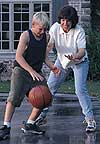 Joining the club
Joining the club
As the mother of triplets, I always had a different perspective than mothers who have kids one at a time. Not better or worse, just different. Because I was raising three sons who were all the same age and in the same grade in school but with different teachers, I was able to make comparisons that other mothers couldn't make, like the three different ways they were taught to read in first grade ("whole language," "phonics" and a combination of the two).
The same held true in youth sports. If my sons were on different teams, I was able to observe and compare coaching styles and philosophies. It afforded me a unique opportunity to identify and distinguish between good coaches and bad, good communication and bad. When you raise multiples, everything is a crash course. There is no way to slow things down, to learn from your mistakes with one child so you don't make the same mistake again with a younger sibling. Mothering multiples thus becomes a constant process of evaluation. I soon learned what coaching style I wanted for all three of my sons, and I eventually put that knowledge to work when I became a licensed soccer coach myself.
No-Mom's-Land
Youth sports organizations say they want more women involved, but the simple fact is that far fewer women coach youth sports then men. Of the 4.1 million youth sports coaches only 654,000 are women. Even women who take the time to get their coaching licenses and want to coach are sometimes denied coaching positions, like happened to me when I initially asked to coach soccer. In 2004, less than a fifth of soccer and Little League coaches were woman.
At the college level, the number of women coaches is actually declining. A study conducted by researchers at Pennsylvania State University found that:
-
Before Title IX. Female college athletes are only half as likely to have female coaches today as they were before Title IX was enacted in 1972.
- Women's teams. A long-term study of gender equity in college athletics, while documenting the explosion in the number of women athletes and women's teams at the college level, reveals the steady and troubling decline in the number of women head coaches. Nine out of ten women's teams were coached by women in 1972, but that number has steadily declined to the point where women held slightly more than four of ten head coaching positions in 2004.
-
Overall. Women hold less than twenty percent of head coaching positions at the college level overall. Only a tiny fraction (2%) are head coaches of men's teams.
The old boy network is alive and well.
In his book Fair Play Scott Lancaster, the Senior Director for NFL Youth Football Development, sees women as "the greatest untapped resource in youth sports." He was puzzled by the absence of woman coaches at the youth sports level. "The sidelines seem to be reserved exclusively for men, while women are relegated to bringing the snacks, driving the carpool, and sitting in the stands rooting for their kids. To me this is clearly one of the most backward traditions in sports today."
As a man perhaps Lancaster's puzzlement as to why such a backward tradition persists is understandable. But for women, the reasons seem obvious: discrimination. The conspicuous absence of women coaches and administrators are clearly the vestiges of the sex-segregated sports system that existed before the passage of Title IX and proof that the "old boy network" in sports is, sad to say, very much alive and well and that youth sports are still a male bastion.
Male athletic administrators, whether at the college, high school or club level, continue to tend to hire, or in the case of youth sports, appoint, other men as administrators and coaches, this despite clear evidence that both coaching and athletic administration are non-gendered professions. Men still hew to the gender stereotype that males are more competent and authoritative.
Not family friendly
Because youth sports practices tend to be scheduled late on weekday afternoons, they accommodate the schedules of working men and women, not those of stay-at-home mothers who may want to coach. The current structure makes it hard for mothers who want to coach to balance the competing demands of family and coaching. The structure needs to be changed to be more mom-friendly. Indeed, argues the author of a 2003 article in The Journal of Physical Education, Recreation & Dance, "If the coach is a mother with young children, the sports program has a moral imperative to offer a babysitting service that will take care of her children. If the mother has older children on the team, the sports community needs to forge a welcoming culture so that she feels empowered to succeed as a coach without worrying about being perceived as a smothering parent."
Adapted from the book, Home Team Advantage: The Critical Role of Mothers in Youth Sports (HarperCollins 2006) by Brooke de Lench.









